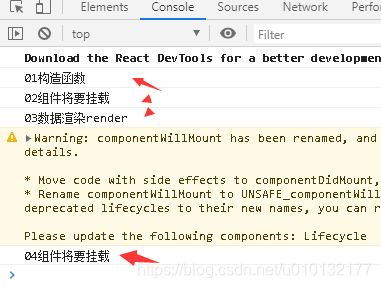详情请点阅读全文
React生命周期函数:
【官方文档】:https://reactjs.org/docs/react-component.html
【定义】组件加载之前,组件加载完成,以及组件更新数据,组件销毁。 触发的一系列的方法 ,这就是组件的生命周期函数
一、组件加载的时候触发的函数:
constructor 、componentWillMount、 render 、componentDidMount
组件加载触发函数实例
【Lifecycle.js】
1
2
3
4
5
6
7
8
9
10
11
12
13
14
15
16
17
18
19
20
21
22
23
24
25
26
27
28
29
30
31
32
33
34
35
36
37
38
| import React, { Component } from 'react';
class Lifecycle extends Component {
constructor(props){
console.log('01构造函数');
super(props);
this.state={
title:'生命同期示例组件'
}
}
componentWillMount(){
console.log('02组件将要挂载');
}
componentDidMount(){
console.log('04组件将要挂载');
}
render() {
console.log('03数据渲染render');
return (
<div>
<h1>生命同期函数:加载时触发的函数</h1>
<br/><hr/>
</div>
);
}
}
export default Lifecycle;
|
【Home.js】
1
2
3
4
5
6
7
8
9
10
11
12
13
14
15
16
17
18
19
20
| import React, { Component } from 'react';
import Lifecycle from './Lifecycle';
class Home extends Component {
constructor(props){
super(props);
this.state={
title:'生命同期函数示例'
}
}
render() {
return (
<div>
<Lifecycle />
</div>
);
}
}
export default Home;
|
【App.js】
1
2
3
4
5
6
7
8
9
10
11
12
13
| import React from 'react';
import './App.css';
import Home from './components/Home.js';
function App() {
return (
<div className="App">
<Home />
<hr/>
</div>
);
}
export default App;
|
【结果】刷新页面,函数将逐个被加载(警告部分不用管它)

二、组件数据更新的时候触发的生命周期函数:
shouldComponentUpdate、componentWillUpdate、render、componentDidUpdate
【Lifecycle.js】
1
2
3
4
5
6
7
8
9
10
11
12
13
14
15
16
17
18
19
20
21
22
23
24
25
26
27
28
29
30
31
32
33
34
35
36
37
38
39
40
41
42
43
44
45
46
47
48
49
| import React, { Component } from 'react';
class Lifecycle extends Component {
constructor(props){
super(props);
this.state={
title:'生命同期示例组件',
msg:'没更新数据之前消息'
}
}
shouldComponentUpdate(nextProps, nextState){
console.log('01是否要更新数据');
console.log(nextProps);
console.log(nextState);
return true;
}
componentWillUpdate(){
console.log('02组件将要更新');
}
componentDidUpdate(){
console.log('04组件数据更新完成');
}
setMsg=()=>{
this.setState({
msg:'我是改变后的msg的数据'
})
}
render() {
console.log('03数据渲染render');
return (
<div>
<h1>生命同期函数:更新数据时触发的函数</h1>
<h2>{this.state.msg}</h2>
<button onClick={this.setMsg}>更新state数据</button>
<br/><hr/>
</div>
);
}
}
export default Lifecycle;
|
【Home.js】
1
2
3
4
5
6
7
8
9
10
11
12
13
14
15
16
17
18
19
20
| import React, { Component } from 'react';
import Lifecycle from './Lifecycle';
class Home extends Component {
constructor(props){
super(props);
this.state={
title:'生命同期函数示例'
}
}
render() {
return (
<div>
<Lifecycle />
</div>
);
}
}
export default Home;
|
【App.js】
1
2
3
4
5
6
7
8
9
10
11
12
| import React from 'react';
import './App.css';
import Home from './components/Home.js';
function App() {
return (
<div className="App">
<Home />
</div>
);
}
export default App;
|
【结果】点按键后,按顺序进行数据更新:

【注】console其中第2、3条数据来自[Lifecycle.js]的【console.log(nextProps); console.log(nextState);】
将在下一主题讲到:三、
三、你在父组件里面改变props传值的时候触发的:
componentWillReceiveProps
【Lifecycle.js】
1
2
3
4
5
6
7
8
9
10
11
12
13
14
15
16
17
18
19
20
21
22
23
24
25
26
27
28
29
30
31
32
33
34
35
36
37
38
39
40
41
42
43
44
45
46
| import React, { Component } from 'react';
class Lifecycle extends Component {
constructor(props){
super(props);
this.state={
title:'生命同期示例组件',
msg:'没更新数据之前消息'
}
}
componentWillReceiveProps(){
console.log('00父子组件传值,父组件里面改变了props的值触发的方法')
}
shouldComponentUpdate(nextProps, nextState){
console.log('01是否要更新数据');
console.log(nextProps);
console.log(nextState);
return true;
}
componentWillUpdate(){
console.log('02组件将要更新');
}
componentDidUpdate(){
console.log('04组件数据更新完成');
}
render() {
console.log('03数据渲染render');
return (
<div>
{}
<h3>{this.props.title}</h3>
<br/><hr/>
</div>
);
}
}
export default Lifecycle;
|
【Home.js】
1
2
3
4
5
6
7
8
9
10
11
12
13
14
15
16
17
18
19
20
21
22
23
24
25
26
27
28
29
30
31
32
33
34
| import React, { Component } from 'react';
import Lifecycle from './Lifecycle';
import { thisTypeAnnotation } from '@babel/types';
class Home extends Component {
constructor(props){
super(props);
this.state={
title:'父组件标题:生命同期函数示例',
flag:true
}
}
changtitle=()=>{
this.setState({
title:'改变后的父组件标题'
})
}
render() {
return (
<div>
<h1>生命周期函数:向子组件传值</h1>
{
//后面的title=xxx为向子组件传值
}
<Lifecycle title={this.state.title} />
<button onClick={this.changtitle}>改变state要传给子组件的值</button>
</div>
);
}
}
export default Home;
|
【App.js】
1
2
3
4
5
6
7
8
9
10
11
12
| import React from 'react';
import './App.css';
import Home from './components/Home.js';
function App() {
return (
<div className="App">
<Home />
</div>
);
}
export default App;
|
【结果】:

点改变之后:

四、组件销毁的时候触发的:
componentWillUnmount
【应用场景】:比如编写文件时,放弃保存,就要销毁那个页面的组件;
【Lifecycle.js】
1
2
3
4
5
6
7
8
9
10
11
12
13
14
15
16
17
18
19
20
21
22
23
24
25
26
27
28
29
30
31
32
33
34
35
36
| import React, { Component } from 'react';
class Lifecycle extends Component {
constructor(props){
super(props);
this.state={
title:'生命同期示例组件',
msg:'没更新数据之前消息'
}
}
componentWillUnmount(){
console.log('组件已销毁');
}
setMsg=()=>{
this.setState({
msg:'我是改变后的msg的数据'
})
}
render() {
console.log('03数据渲染render');
return (
<div>
<h2>{this.state.msg}</h2>
<button onClick={this.setMsg}>更新state数据</button>
<br/><hr/>
</div>
);
}
}
export default Lifecycle;
|
【Home.js】
1
2
3
4
5
6
7
8
9
10
11
12
13
14
15
16
17
18
19
20
21
22
23
24
25
26
27
28
29
30
31
32
33
34
35
36
| import React, { Component } from 'react';
import Lifecycle from './Lifecycle';
class Home extends Component {
constructor(props){
super(props);
this.state={
title:'生命同期函数示例',
flag:true
}
}
setFlag=()=>{
this.setState({
flag:!this.state.flag
})
}
render() {
return (
<div>
<h1>销毁组件生命周期函数示例</h1>
{ //【是否销毁子组件重点代码】:如果flag=true加载<Lifecycle />组件,否则加载空;
this.state.flag?<Lifecycle />:""
}
<br/>
<button onClick={this.setFlag}>销毁/加载子组件</button>
</div>
);
}
}
export default Home;
|
【App.js】
1
2
3
4
5
6
7
8
9
10
11
12
| import React from 'react';
import './App.css';
import Home from './components/Home.js';
function App() {
return (
<div className="App">
<Home />
</div>
);
}
export default App;
|
【结果】:

【点销毁后】:

五、【总结】必须记住的生命周期函数:
*加载的时候:componentWillMount、 render 、componentDidMount(dom操作要放此处)
更新的时候:componentWillUpdate、render、componentDidUpdate
*销毁的时候: componentWillUnmount





